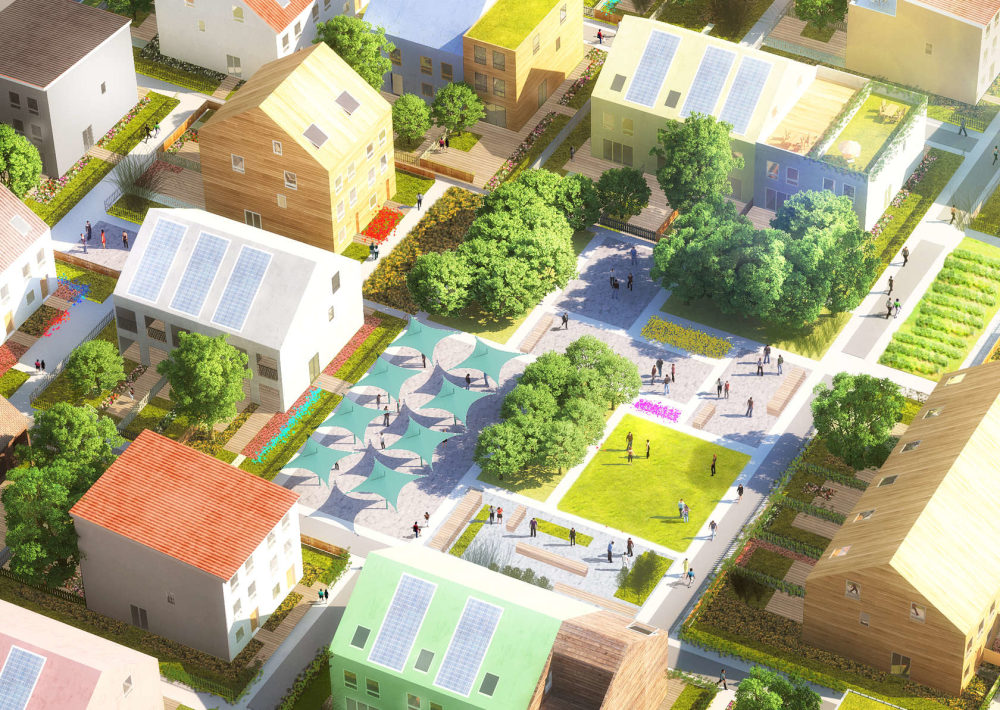
Suburbia, the scourge of contemporary urban planners everywhere, is about to be turned on its proverbial head thanks to avant-garde firm MVRDV. The Dutch firm is partnering with housing developers Traumhaus to transform a former US Army barracks in Mannheim, Germany, and it has taken the opportunity to carry out a rigorous reexamination of our urban edges in search of a new solution.
The drawbacks of conventional suburban growth have been well-documented. The dominance of large-scale commercial developers and a lack of strategic planning on the part of city councils around Europe and farther afield has led to low-density districts that suffer from a lack of architectural diversity, poor social cohesion and low-quality affordable housing, amongst other issues. Rising land prices have also put a squeeze on developers to minimize public open spaces, and a growing reliance on inner-city amenities has meant the vitality of many peripheral residential estates has dropped.
For Mannheim’s Funari neighborhood, MVRDV are aiming to address these issues in a multitude of different ways, and have illustrated their proposals with a striking series of colorful renderings and diagrams. The overriding strategy pertains to multiplicity, with the firm customizing regional archetypes to create a vibrant architectural collage of buildings. “A huge range of variations on the Traumhaus standard typology will be distributed throughout the site,” says MVRDV, “encouraging social diversity as well as a lively mix of different lifestyles.”
The resulting layout is a festival of color, texture and form, with classic pitch-roofed dwellings wrapped in an array of different materials, their forms subtly modified to provide a range of homes with a highly distinctive character. Green spaces including urban farms, flower gardens and play spaces contribute to a master plan that evokes a patchwork quilt, rich in variety. Meanwhile, the Housing Catalogue lays out an assortment of potential typologies, each one a twist on the vernacular Traumhaus dwelling.
Characteristically quirky suggestions typify MVRDV’s culture of experimentation: the ‘Round Corner House’ defies the conventions of terraced dwellings, while the ‘Elevated Tall House’ boasts a garden beneath an abode that soars above the surrounding rooftops. Indeed, variations for the external space of each home are also proposed; residents are offered the chance to customize their gardens with a plethora of landscape features including reed beds, fruit trees and sunbathing terraces.
Perhaps the most exciting aspect of the firm’s concept is its “Build Your Own” proposal. A multitude of designated design styles — Traumhaus Standard, Opened House, Individualised House and Futuristic House are illustrated examples — would allow for a refreshing semblance of bespoke design within estates at the periphery of cities. Such customization would enrich suburban landscapes that are currently dominated by cookie-cutter-style homes, their appearance characterized by massed-produced monotony.
There will undoubtedly be question marks over both the commercial viability and scalability of the proposal, given that any deviation from developer’s standard house types and increases in open space amenities will markedly increase costs. However, MVRDV Founding Partner Winy Maas has found a willing client in the shape of Traumhaus, and the scheme demonstrates the potential for attractive, innovative design to increase property values across the board, offsetting the initial outlay to developers.
“Funari brings back the varied neighborhood. It’s where you know your diverse community, where the kids can run around in the street, where your home is exactly what you need it to be,” explained Maas. “But also it’s a comment on the housing system today. A system where young people can’t afford to buy, where ‘affordable housing’ is of such a poor quality and where the suburban dream stamps out community spirit and individual expression. We want to show that there is another way.”
MVRDV’s preferred graphic style — featuring bold colors, axonometric angles and legible captions — is the perfect medium to communicate such a proposal. Its aesthetic is high on clarity, but also possesses a sense of humor that will only make this vision more compelling to a wider audience. Traumhaus should also be given credit for their willingness to entertain such an experimental twist on their established model. If the barracks in Mannheim come to resemble anything like MVRDV’s renderings, they are likely to form a key precedent in future attempts to reinvent suburbs across the globe.
